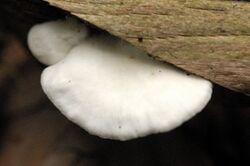Biology:Crepidotus mollis
| Crepidotus mollis | |
|---|---|

| |
| Scientific classification | |
| Domain: | Eukaryota |
| Kingdom: | Fungi |
| Division: | Basidiomycota |
| Class: | Agaricomycetes |
| Order: | Agaricales |
| Family: | Crepidotaceae |
| Genus: | Crepidotus |
| Species: | C. mollis
|
| Binomial name | |
| Crepidotus mollis (Schaeff.) Staude
| |
Crepidotus mollis, commonly known as the peeling oysterling, soft slipper, jelly crep, or flabby crepidotus,[1] is a species of mushroom. It's edibility is unknown,[1] but it is probably inedible and possibly poisonous.[2]
Description
The cap is 1–5 cm wide and kidney shaped.[3] The cap is white when it is young and when it gets older, it turns ochre. The flesh of the cap is white and flabby,[4] and can be broken easily. It has brown fibrils and scales which wear away, leaving a smooth surface.[3] The upper layer of the cap is elastic and can be stretched slightly at the margin.[5] The gills are pale brown and soft.[6] The spores are elliptical and smooth,[7] producing a brown spore print.[6] The stalk is rudimentary or lacking.[5] Crepidotus crocophyllus looks similar to this species[4] and is sometimes confused with it.[7] The species resemble a globe in moist weather.[8] The species has a relative large size compared to other species in the genus Crepidotus.[9] The fungus Hypomyces tremellicola is a parasite that deforms this species' cap.[10]
The species is reportedly inedible,[11] and too small to consider worthwhile.[7] Since very little is known about the edibility of the mushrooms in the genus Crepidotus, none should be eaten.[12]
Similar species
Similar species include Crepidotus applanatus, C. crocophyllus, and Pleurotus ostreatus.[3]
Habitat
The species grows in groups or overlapping tiers on hardwood.[4] The hardwood includes tree trunks, fallen branches, and sawdust. Rarely, the species grows on coniferous trees.[12] The species is widely distributed and very common.[4] The months that the species can commonly be found in are from July to September.[13] The species can be found in temperate zones of North America, South America, and The British Isles. It can also be found in Europe during spring, summer, and autumn.[14]
| Crepidotus mollis | |
|---|---|
| Mycological characteristics | |
| gills on hymenium | |
| cap is convex or flat | |
| lacks a stipe | |
| spore print is brown to yellow-brown | |
| ecology is saprotrophic | |
| edibility: unknown or inedible | |
References
- ↑ Jump up to: 1.0 1.1 Arora, David (1986). Mushrooms demystified: a comprehensive guide to the fleshy fungi (Second ed.). Berkeley: Ten Speed Press. ISBN 978-0-89815-169-5.
- ↑ "Crepidotus mollis, Peeling Oysterling, identification". https://first-nature.com/fungi/crepidotus-mollis.php.
- ↑ Jump up to: 3.0 3.1 3.2 Davis, R. Michael; Sommer, Robert; Menge, John A. (2012). Field Guide to Mushrooms of Western North America. Berkeley: University of California Press. pp. 231–232. ISBN 978-0-520-95360-4. OCLC 797915861. https://www.worldcat.org/oclc/797915861.
- ↑ Jump up to: 4.0 4.1 4.2 4.3 Arora, David (1986). Mushrooms demystified: a comprehensive guide to the fleshy fungi. 406: Ten Speed Press. p. 406. ISBN 978-0-89815-169-5. https://archive.org/details/mushroomsdemysti00aror_0. "Crepidotus mollis."
- ↑ Jump up to: 5.0 5.1 C. Roody, William (2003). Mushrooms of West Virginia and the Central Appalachians. University Press of Kentucky. pp. 124. ISBN 978-0-8131-9039-6. https://books.google.com/books?id=5HGMPEiy4ykC&dq=Crepidotus+mollis&pg=PA18.
- ↑ Jump up to: 6.0 6.1 "Crepidotus mollis". First Nature. http://www.first-nature.com/fungi/id_guide/cortinariales/crepidotus_mollis.htm.
- ↑ Jump up to: 7.0 7.1 7.2 Miller Jr., Orson K.; Miller, Hope H. (2006). North American Mushrooms: A Field Guide to Edible and Inedible Fungi. Guilford, CN: FalconGuide. pp. 285. ISBN 978-0-7627-3109-1.
- ↑ Sayer Moffatt, Will (1909). The higher Fungi of the Chicago region. The Academy. pp. 87. https://archive.org/details/higherfungiofchi01moffrich. "Crepidotus mollis."
- ↑ Gibson, Ian. "CREPIDOTUS in the Pacific Northwest". South Vancouver Island Mycological Society. http://www.svims.ca/council/Crepid.htm.
- ↑ Authors, Multiple (2008). Mushrooms and other fungi of the midcontinental United States. University of Iowa Press. pp. 71. ISBN 978-1-58729-627-7. https://books.google.com/books?id=tl2fVAHuej4C&dq=Crepidotus+mollis&pg=PA70.
- ↑ Phillips, Roger (2010). Mushrooms and Other Fungi of North America. Buffalo, NY: Firefly Books. pp. 242–43. ISBN 978-1-55407-651-2. https://archive.org/details/mushroomsotherfu0000phil.
- ↑ Jump up to: 12.0 12.1 Pacioni, Giovanni; Lincoff, Gary (1981). Simon and Schuster's Guide to mushrooms. Simon and Schuster. pp. 290. ISBN 978-0-671-42849-5. https://books.google.com/books?id=LydcGycgWZ0C&dq=Crepidotus+mollis&pg=PA289.
- ↑ Authors, Multiple (1997). Mushrooms of northeastern North America. Syracuse University Press. pp. 114. ISBN 978-0-8156-0388-7. https://books.google.com/books?id=T2uU12XcRD4C&dq=Crepidotus+mollis&pg=PA114.
- ↑ "The North American Species of Crepidotus". MykoWeb. http://www.mykoweb.com/Crepidotus/species/Crepidotus_mollis.html.
External links
Wikidata ☰ Q2251383 entry
 |

